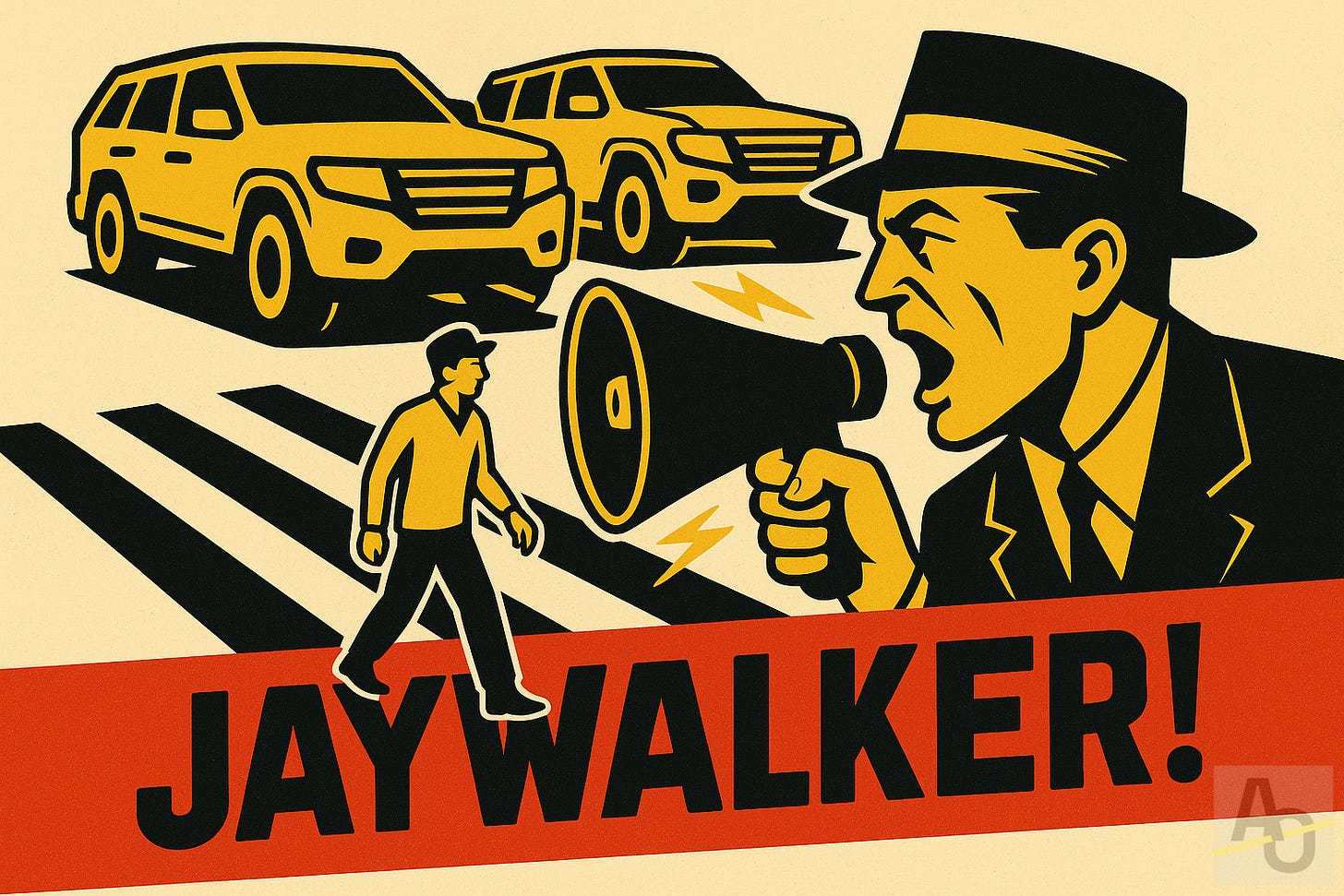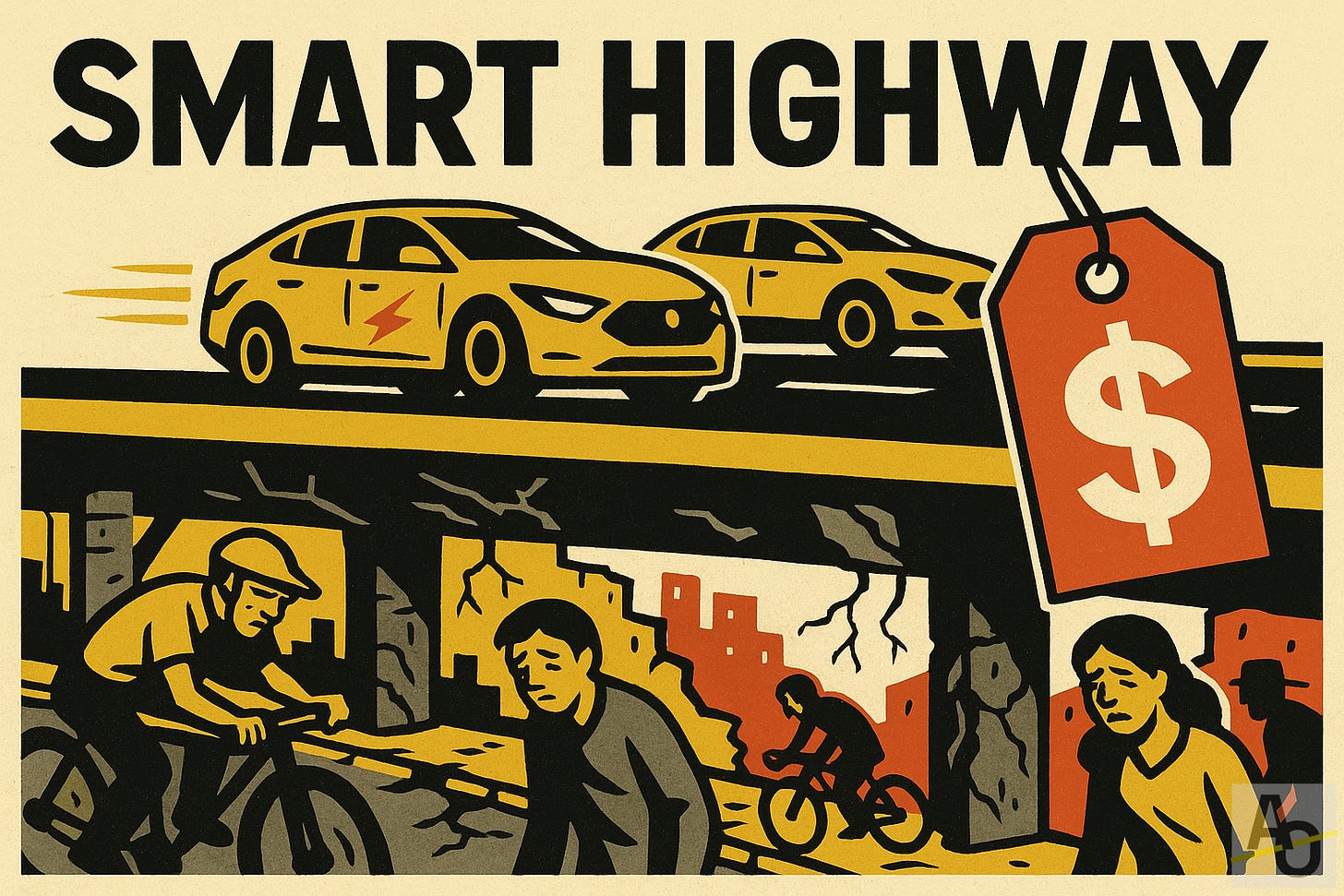Built for Cars, Unfit for Humans
How a 1920s PR coup sold ‘driving = freedom,’ leaving today’s pedestrians dodging speeding cars, mounting fines, and accepting mortal danger as the everyday normal.
By Kanishka S. for Atlas October
An Everyday Everest on EDSA
Walk the northbound side of EDSA at Kamuning (Metro Manila, Philippines) and the street tells you exactly where you rank. First, a twenty-plus-step stair run, then a second flight, then a third—the infamous “Mt. Kamuning” footbridge that hoists pedestrians a good three storeys above the diesel roar. Dutch consul Dirk Janssen snapped a photo and delivered the most succinct review yet: “There is no better way to make it clear to pedestrians that they don’t matter.”
Scale back down and you meet another message in steel: ₱1,000 fines for “jaywalking”—double the previous penalty, if recent Metropolitan Manila Development Authority (MMDA) proposals pass. Those fines guard a network of 133 elevated crossings Metro Manila has built, almost all on expressways like EDSA, explicitly to sweep people out of the cars’ way.
How did we get a street hierarchy so hostile that simply crossing the road feels like trespassing? The answer starts a century—and an ocean—away.

Myth 1 | Cars are Inevitable
1.1 The PR coup that invented the “wrong” pedestrian
Back in 1919 Cleveland (Ohio, USA) staged “Safety Week.” Automakers, oil firms, and road-builders—together calling themselves “motordom”—filled parades with floats and banners teaching citizens a new word: jaywalker. If you stepped into the roadway anywhere but the designated crossing you were the hick, the jay, the problem. Within five years newspapers across the United States, from Los Angeles to Providence were reprinting motordom press kits; city councils were turning the slur into law.
1.2 How the meme went global
The U.S. exported more than automobiles—it shipped its traffic manuals, asphalt standards, and funding models through aid programmes and engineering consultancies. Post-war Philippines borrowed them wholesale, planning wide arterials, banning curbside vendors, and, eventually, lifting pedestrians into the sweaty sky rather than slowing cars on the ground.
1.3 EDSA as living exhibit
That is why a Manila commuter in 2025 climbs “Mt. Kamuning” and pays the price—literally—if they try the shorter route. The street is not obeying a law of nature; it’s following a century-old marketing playbook. If you bust that origin story, inevitability evaporates.
Myth 2 | More Cars = Progress
2.1 Congestion costs that dwarf the gains
In 2024 Houston (Texas, USA) drivers lost 66 hours each—an entire workweek—sitting in traffic, at a personal cost of US $1,181 and a city-wide hit of US $3.5 billion that year. Nearly every household owns at least one car, and most own two.
Contrast that with Copenhagen. A brutal 150% purchase tax on vehicles keeps ownership at about 29% of households, yet the Danish capital just unseated Vienna (Austria) as the world’s most liveable city with a score of 98/100 in the 2025 EIU index. The city’s GDP-per-capita tracks Houston’s, but its streets move more people with a fraction of the vehicles.
2.2 Health and air: the hidden invoice
Ulaanbaatar, Mongolia shows the other end of the curve. Car numbers soared after 2000; today road deaths sit around 21.5 per 100,000 and air pollution averages PM2.5 tops 41 µg/m³—eight-times the World Health Organization (WHO) guideline. Copenhagen’s pedestrian-and-bike priority status, by contrast, helps keep its fatality rate below one per 100,000 and its air among Europe’s cleanest.
2.3 Progress that steals time, mood and democracy
Congestion research tallies fuel and payroll, but the meter keeps running:
Family time lost—Houston’s 66 stalled hours erase two long weekends with loved ones each year.
Mental health drag—studies across Latin America link longer traffic delays (not distance) to a significantly higher probability of clinical depression.
Civic fade-out—literature reviews find every extra ten minutes behind the wheel chops local civic participation by roughly ten percent.
More cars deliver less prosperity, less health, and less community—hardly anyone’s definition of progress.
Myth 3 | Technology Will Fix the Downsides
Swap the engine, add AI, we’re told, and keep the streets exactly as they are.
Electric Vehicles erase tail-pipe CO₂ yet anchor the same congestion geometry and unleash new frontiers of lithium, nickel, and cobalt mining.
Self-driving cars promise fewer crashes but, by slashing the “cost” of driving time, risk luring even more trips. We have a term for this, induced demand; it’s the same reason why “adding more lanes” doesn't fix traffic.
Smart AI-managed highways squeeze marginal efficiency from asphalt while diverting billions toward road widening, not away from it.
None of these “fixes” widens a sidewalk, spares a pedestrian the Kamuning climb, or rewrites a budget line item. They are, at best, high-tech seat-covers on the same dead-end design.

Busted | If Marketing Built the Problem, Design Can Unbuild It
Streets built for cars breed cities unfit for humans, it’s time to redraw the map.
Spend one day this week moving only as a pedestrian, cyclist, or transit rider through your city. Document every moment the street tells you you don’t belong—the footbridge climb, the vanishing sidewalk, the “jaywalking” sign—and share one photo or story with the hashtag #UnfitForHumans. Let’s crowdsource an atlas of places that deserve a redesign before the next century of asphalt sets.
Endnotes
Dirk Janssen – Tweet from the Dutch Consul General in Manila describing the Kamuning footbridge as proof “pedestrians don’t matter,” 24 April 2019.
Metropolitan Manila Development Authority (MMDA) – Press briefing and follow-up news coverage in The Philippine STAR, 6 October 2023, on the proposal to raise “jaywalking” fines to ₱1 000.
MMDA Footbridge Inventory – Agency presentation, June 2023, listing 133 pedestrian overpasses in Metro Manila (most located on EDSA and C-5).
Peter D. Norton – “Street Rivals: Jaywalking and the Invention of the Motor-Age Street,” Journal of Transport History, Vol. 26, No. 1 (2007).
INRIX – 2024 Global Traffic Scorecard: Houston drivers lost 66 hours and US $1 181 each to congestion, totalling ~US $3.5 billion city-wide.
Governing Magazine / U.S. Census American Community Survey (2023) – Vehicle-ownership dataset showing roughly 92 % of Houston households own at least one car.
Danish Ministry of Taxation & City Observatory analysis (2024) – Documentation of Denmark’s 150 % new-car purchase tax and Copenhagen’s 29 % car-owning households.
Economist Intelligence Unit (EIU) – Global Liveability Index 2025 ranking Copenhagen #1 worldwide and Osaka #8.
World Health Organization – Global Status Report on Road Safety 2023 (using 2021 data) listing Mongolia’s road-traffic mortality at 12.4 per 100 000 population.
Batmunkh et al. – “Long-term Trends of PM₂.₅ Pollution in Ulaanbaatar, Mongolia (1990–2020),” PLOS ONE, March 2025, reporting annual means of 36–46 µg/m³.
Lancet Psychiatry meta-analysis – “Commute Duration and Mental-Health Outcomes,” February 2024, finding markedly higher depression risk beyond 60 minutes of daily traffic delay.
Robert D. Putnam – Interview in CommonWealth Beacon, August 2023, summarising updated Bowling Alone research: every additional 10 minutes of daily car commuting lowers local civic participation by roughly 10 %.


Actually, the streets in most places I’ve lived are unfit for living beings, period. Also super dangerous for non-human animals wandering around. And there are a lot of strays that need homes. Maybe another potential topic for you :)